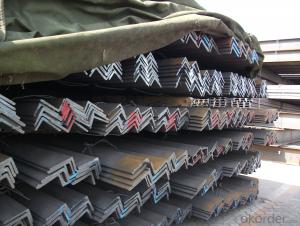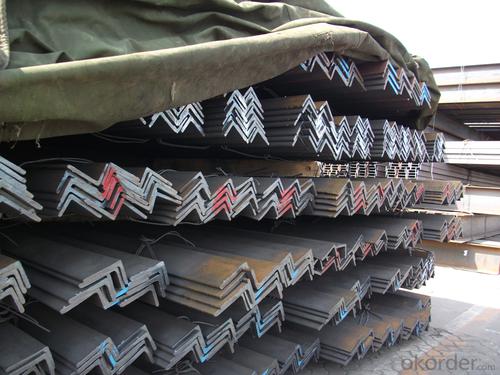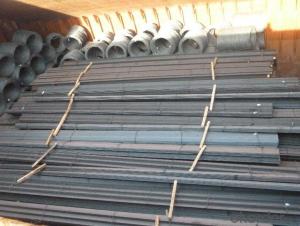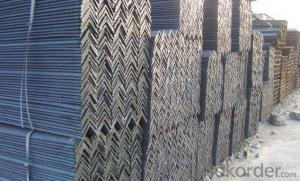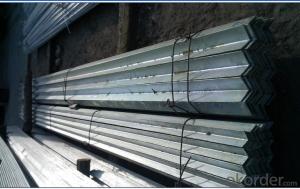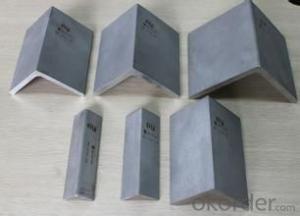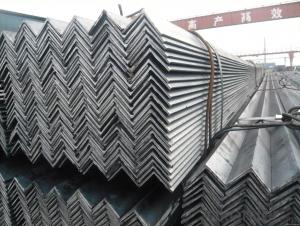JIS Unequal Steel Angle
OKorder Service Pledge
OKorder Financial Service
You Might Also Like
Specifications of Unequal Angle Steel:
1.Standards: JIS
2.Length: 6m,9m,12m
3.Material: SS400 or Equivalent
4. Size:
Size (mm) | Mass (mm) | Size (mm) | Mass (mm) |
| 75*50*5.0 | 4.8 | 75*50*8.0 | 7.43 |
| 75*50*6.0 | 5.66 | 100*75*6.0 | 8.04 |
Packaging & Delivery of Unequal Angle Steel
1. Transportation: the goods are delivered by truck from mill to loading port, the maximum quantity can be loaded is around 40MTs by each truck. If the order quantity cannot reach the full truck loaded, the transportation cost per ton will be little higher than full load.
2. With bundles and load in 20 feet/40 feet container, or by bulk cargo, also we could do as customer's request.
3. Marks:
Color mark: There will be color marking on both end of the bundle for the cargo delivered by bulk vessel. That makes it easily to distinguish at the destination port.
Tag mark: There will be tag mark tied up on the bundles. The information usually including supplier logo and name, product name, made in China, shipping marks and other information request by the customer.
If loading by container the marking is not needed, but we will prepare it as customer request.
*If you would like to get our price, please inform us the size, standard/material and quantity. Thank you very much for your attention.
- Q: Are steel angles suitable for playground equipment?
- Yes, steel angles are suitable for playground equipment. They provide structural support, stability, and durability, making them ideal for creating safe and long-lasting playground structures.
- Q: What are the different types of steel angles used in storage tank construction?
- There are several types of steel angles used in storage tank construction, including L-shaped angles, T-shaped angles, and unequal angles. L-shaped angles are commonly used for the tank shell and roof support, while T-shaped angles are often used for the tank bottom and annular ring. Unequal angles are used for reinforcing various sections of the tank structure.
- Q: How do steel angles compare to wooden or concrete structural elements?
- Steel angles have several advantages over wooden or concrete structural elements. Firstly, steel angles are known for their exceptional strength and durability. They can bear heavy loads and resist deformation, making them ideal for supporting large structures or bridges. In comparison, wooden elements are prone to rot, warping, and degradation over time, while concrete elements may develop cracks or suffer from corrosion. Additionally, steel angles offer a high level of versatility in terms of design and construction. They can be easily fabricated into various shapes and sizes, allowing for customized solutions for different structural needs. This flexibility is not easily achievable with wooden or concrete elements, which are limited by their natural properties and construction techniques. Moreover, steel angles provide excellent fire resistance compared to wooden elements, which are highly flammable. Steel does not burn, and its structural integrity remains intact even in high-temperature environments. Concrete also offers fire resistance, but steel angles have the advantage of being lightweight, reducing the overall load on the structure. Another significant advantage of steel angles is their resistance to pests, such as termites or rodents, which can severely damage wooden structures. Steel is impervious to these threats, ensuring long-term stability and reducing maintenance costs. However, there are some drawbacks to using steel angles as well. One of the main concerns is the potential for corrosion, especially in environments with high moisture or chemical exposure. Regular maintenance, including protective coatings or galvanization, is necessary to prevent rust formation and maintain the steel's structural integrity. Furthermore, steel angles tend to have a higher upfront cost compared to wooden elements. However, their long-term durability and reduced maintenance requirements often result in cost savings over time. In conclusion, steel angles offer numerous advantages over wooden or concrete structural elements, including superior strength, versatility, fire resistance, pest resistance, and long-term durability. However, considerations such as corrosion prevention and initial costs should be taken into account when deciding on the most suitable structural material for a specific project.
- Q: How do steel angles perform in high-pressure applications?
- Steel angles are widely used in high-pressure applications due to their excellent performance under extreme conditions. The structural design and composition of steel angles provide them with exceptional strength and durability, making them capable of withstanding high pressure without deformation or failure. The unique shape of steel angles, with their L-shaped cross-section, enhances their load-bearing capacity and resistance to bending. This makes them ideal for applications where high-pressure forces are exerted, such as in the construction of pressure vessels, pipelines, and hydraulic systems. Steel angles are typically manufactured from high-strength carbon steel, which possesses inherent toughness and resilience. This material composition enables steel angles to maintain their structural integrity even when subjected to the intense forces associated with high-pressure environments. Furthermore, the versatility of steel angles allows for customization and adaptation to specific needs. They can be fabricated in different sizes, thicknesses, and lengths to accommodate varying pressure requirements. This flexibility ensures that steel angles can be tailored to specific applications, further enhancing their performance in high-pressure scenarios. In addition to their mechanical properties, steel angles also exhibit excellent corrosion resistance. This is crucial in high-pressure applications, as the presence of corrosive substances can deteriorate the structural integrity of components. The inherent corrosion resistance of steel angles prevents degradation over time, ensuring their long-term reliability and performance. Overall, steel angles are highly reliable and effective in high-pressure applications. Their exceptional strength, versatility, and corrosion resistance make them a preferred choice in industries where pressure containment is critical. By utilizing steel angles, operators can trust that their systems will perform reliably and safely under extreme pressure conditions.
- Q: Can steel angles be used for retaining walls?
- Yes, steel angles can be used for retaining walls. Steel angles provide structural support and stability, making them suitable for retaining walls that need to withstand the pressure of soil or other materials. They offer durability and resistance to corrosion, making them a popular choice for retaining wall construction.
- Q: How can steel angles be cut to size?
- There are various methods available for cutting steel angles to size, depending on the tools and equipment that are accessible. One common approach involves utilizing a power saw equipped with a metal cutting blade. This particular saw allows for clean and precise cuts, enabling accurate sizing of the steel angles. Another option involves using an angle grinder with a cutting wheel attachment. This handheld tool can be easily maneuvered to cut through the steel angles, although the resulting cut may not be as clean as that achieved with a power saw. For smaller and thinner steel angles, a hacksaw can also be utilized. Although this manual tool requires more effort, it can still deliver accurate cuts. Furthermore, certain fabrication shops may possess more specialized cutting equipment, such as a plasma cutter or a water jet cutter, which offer even greater precision and efficiency. Ultimately, the choice of method for cutting steel angles to size will depend on the specific requirements and available resources.
- Q: Can steel angles be used for framing partitions and walls?
- Indeed, framing partitions and walls can be accomplished by utilizing steel angles. In construction, steel angles are extensively employed due to their robustness and longevity. A framework for partitions and walls can be established by employing steel angles, which offer structural reinforcement and stability. Steel angles possess adaptability, enabling them to be effortlessly cut and welded to fit desired dimensions and angles. Moreover, they exhibit resistance to fire, pests, and moisture, rendering them an ideal selection for framing interior walls and partitions in both commercial and residential structures.
- Q: What are the different types of steel angles used in signage structures?
- There are several different types of steel angles that are commonly used in signage structures. These angles are used to provide structural support and stability to the signage, ensuring that it remains in place and can withstand various weather conditions. 1. Equal Angles: Equal angles, also known as L-shaped angles, have equal sides and are commonly used in signage structures. These angles provide a strong and sturdy framework for the signage, allowing it to withstand wind and other external forces. 2. Unequal Angles: Unequal angles, as the name suggests, have sides of unequal length. These angles are often used in signage structures where different sides of the signage require varying levels of support. Unequal angles can be tailored to meet specific design requirements and can provide added stability to the signage. 3. Hollow Structural Sections (HSS): HSS angles are steel angles that have a hollow interior. These angles are widely used in signage structures due to their lightweight nature and high strength-to-weight ratio. HSS angles are especially useful when constructing large and complex signage structures, as they help reduce the overall weight and allow for easier installation. 4. Corner Angles: Corner angles are used to reinforce the corners of signage structures, providing additional support and preventing any potential bending or warping. These angles are typically made from thicker steel and are designed to withstand high levels of stress and pressure. 5. Galvanized Angles: Galvanized angles are steel angles that have been coated with a layer of zinc to protect them from rust and corrosion. These angles are commonly used in outdoor signage structures, where they are exposed to moisture and other environmental elements. The galvanized coating ensures the longevity and durability of the angles, prolonging the lifespan of the signage structure. Overall, the choice of steel angles used in signage structures depends on factors such as the size and design of the signage, the expected load and stress, and the environmental conditions. By selecting the appropriate type of steel angle, signage structures can be built to withstand the rigors of outdoor environments and provide long-lasting support for various types of signage.
- Q: How do steel angles contribute to the overall strength of a structure?
- Steel angles contribute to the overall strength of a structure in several ways. First and foremost, they provide structural stability by distributing the load and forces evenly throughout the structure. The L-shape of steel angles allows them to resist bending and twisting, making them ideal for providing support and preventing deformation. Steel angles are often used as bracing elements in construction due to their high strength-to-weight ratio. By adding diagonal steel angles to a structure, it becomes more resistant to lateral forces such as wind or seismic loads. These angles help to transfer the applied forces to the foundation, reducing the risk of structural failure. Another way steel angles contribute to strength is by providing additional reinforcement. They can be strategically placed at critical points of a structure, such as corners or joints, to enhance its overall rigidity and durability. Steel angles can also be used as framing members, supporting beams, or columns, further enhancing the load-bearing capacity of the structure. Moreover, steel angles are resistant to corrosion and have a long lifespan, making them a reliable choice for structural applications. They can withstand harsh environmental conditions, ensuring the structural integrity of the building over time. Overall, steel angles play a crucial role in enhancing the strength and stability of a structure. Their ability to distribute loads, resist bending and twisting, provide reinforcement, and withstand environmental factors make them an essential component in modern construction.
- Q: What are the different types of connections used for steel angles in residential applications?
- There are several different types of connections used for steel angles in residential applications. Some of the most commonly used ones include: 1. Welded connections: This is the most common type of connection used for steel angles. It involves welding the angle to the adjacent structural members, such as beams or columns. Welded connections provide excellent strength and rigidity, making them ideal for residential applications. 2. Bolted connections: Bolted connections involve using bolts and nuts to secure the steel angle to the adjacent members. This type of connection is often used when the angle needs to be easily removable or adjustable. Bolted connections are less rigid than welded connections but still provide sufficient strength for residential applications. 3. Clip connections: Clip connections are typically used to connect steel angles to wood or other non-steel materials. They involve using clips or brackets that are attached to the angle and then fastened to the adjacent material using screws or nails. Clip connections are commonly used in residential framing applications. 4. Gusset plate connections: Gusset plate connections are used when two steel angles need to be connected at a joint. A gusset plate, which is a flat plate of steel, is welded or bolted to the angles to provide additional support and rigidity. This type of connection is often used in residential roof trusses and other structural applications. 5. Cleat connections: Cleat connections involve using a steel plate, called a cleat, that is bolted or welded to the steel angle and the adjacent member. Cleat connections are commonly used when the angle needs to be attached to a horizontal member, such as a floor or roof joist. These are just a few examples of the different types of connections used for steel angles in residential applications. The choice of connection type will depend on factors such as the structural requirements, ease of installation, and the type of materials being connected.
Send your message to us
JIS Unequal Steel Angle
OKorder Service Pledge
OKorder Financial Service
Similar products
Hot products
Hot Searches
Related keywords
